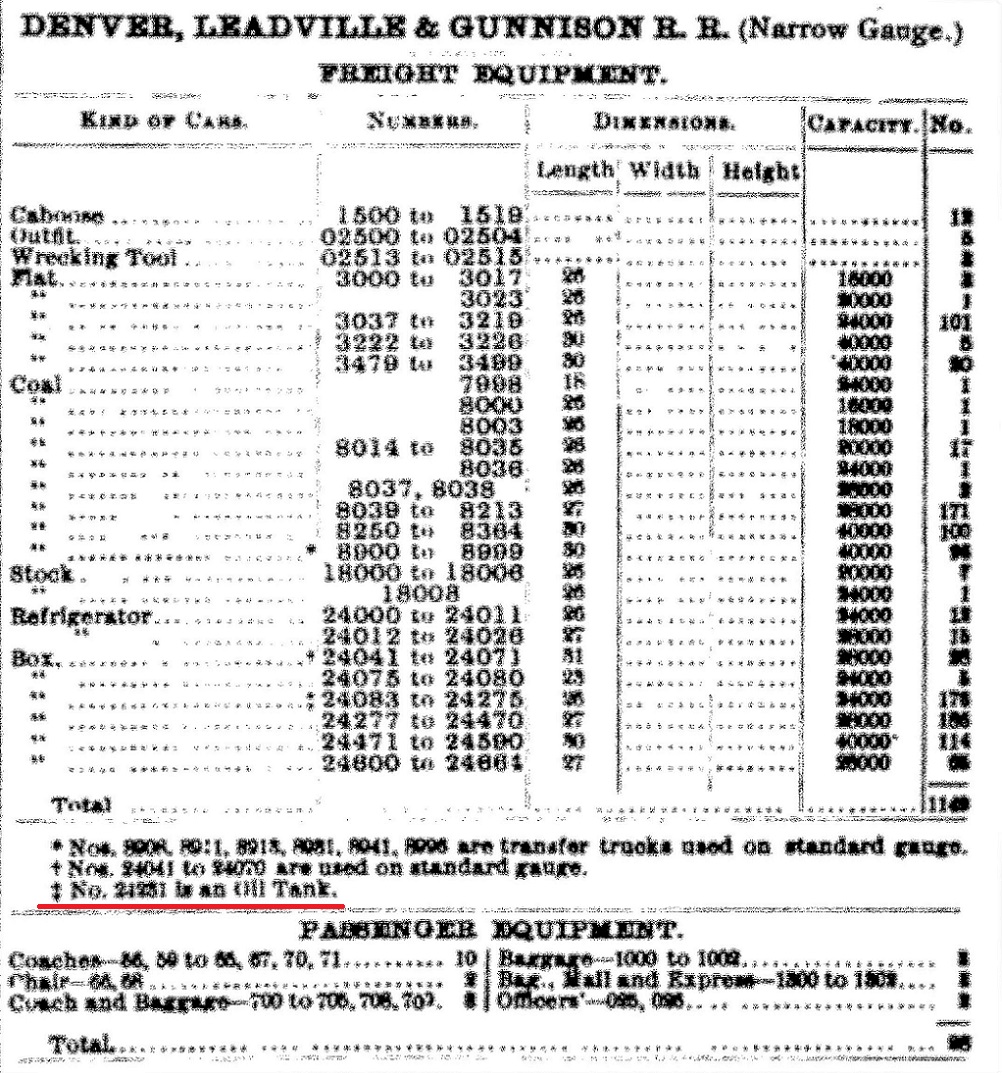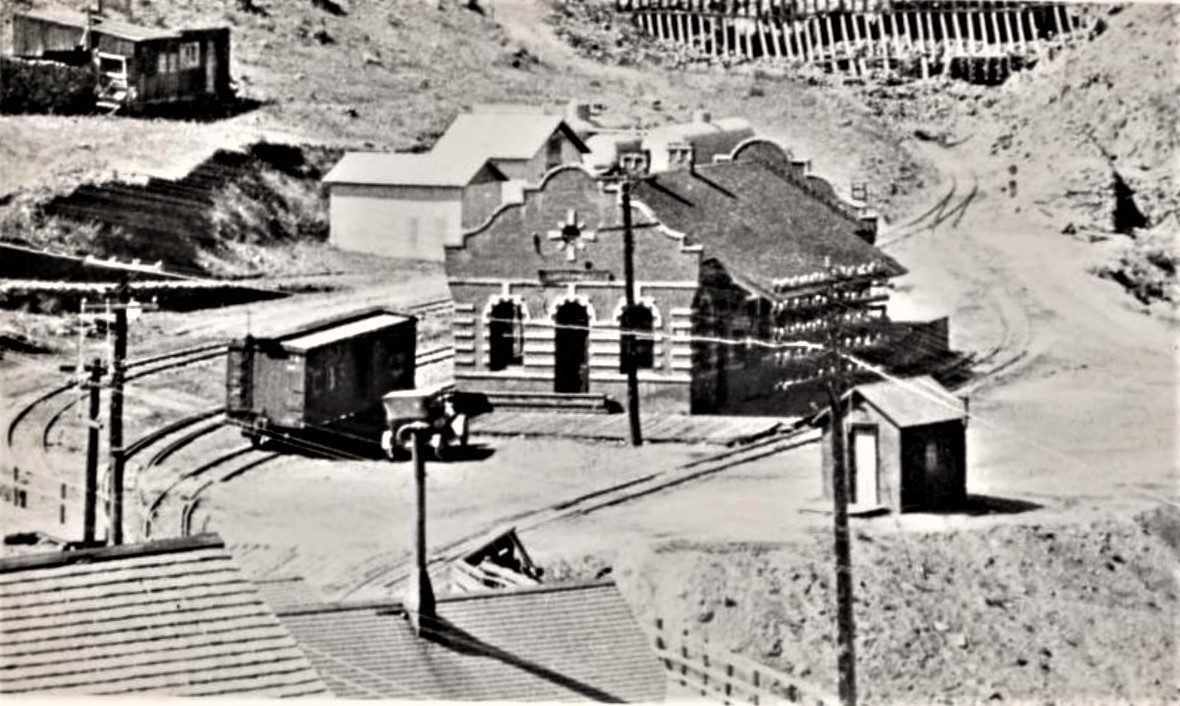First Decade C&S Lineside Petroleum Tanks . . . and Tank Cars?
12




12
Re: First Decade C&S Lineside Petroleum Tanks . . . and Tank Cars?
|
This post was updated on .
I was also tempted to define the first and last number in the series as being the two car numbers but that isn't always the case. I've seen plenty of these lists giving number ranges with only a handful of cars in the range. In several cases those cars were numbered with the first numbers in the series, not the first and last. In others, they were numbers spread across the series--and not necessarily the first or the last.
1055 is listed in the ORER as a flat in 1904, 1905 and 1906, not just 1907. It's also listed as a flat in 1908-1912. And it's listed as a flat, not a tank, in December 1902, the year Darrell says it was converted. It's important to note that by listed I mean the number is in the allocated range of numbers for cars of that type. Whether the specific number is in service or not isn't given. All I'm getting out of the ORER definitively from 1899 to 1912 is there were 1-2 flats with tanks on them, reported only in 1902, 1903, 1907 and 1908. Only 1907 and 1908 call out specific car numbers, not a range: 01056 and 01066. There's not enough info in the ORER to say there's a typo here, not enough to say there isn't. We know they had water cars, we know roughly when, what type of flatcar they rode on, and two car numbers. The Fiscal Reports of 1904 and 1905 list 2 and 3 cars with water tanks, giving flatcar type but no numbers. A lot of unanswered questions. I'm interested in the primary source Derrell used that shows 1055 as a tank car, in 1902. His source, I'm guessing, is a company roster of some type. And from what I read in Pictorial VIII, it doesn't appear to answer the petroleum tank question. But it might answer more on these water cars. Do you know his primary source?
Dave Eggleston
Seattle, WA |
Re: Pre-C&S Narrow Gauge Tank Cars?
|
This post was updated on .
So far in this thread, we have established that there were several lineside bulk storage tanks on the Clear Creek line and one at Breckenridge, in the late 1890s and early first decade.
We have established that the early C&S converted a couple of Peninsular flat cars by mounting tanks on them, for the purpose of transporting and storing locomotive fuel oil, for the 1902 "smokeless" summer excursions. When this plan fell through, due to a sudden spike in oil prices, the tank cars were apparently repurposed as "water cars". Dave posted above that there is no evidence of pre-C&S tank cars. So I was surprised when re-reading Ron Rudnick's UPD&G / DL&G Modeling Guide, Version 6.1 and got to the very last page, showing the all time UPD&G / DL&G roster: Ron's roster notes that the UPD&G had an "Oil Tank", numbered UPD&G 4232. The car was one of 24 cars, series 4213-4237, that were 26-foot flat cars, built by the Union Pacific shops for the Colorado Central in 1873. The term "Oil Tank" implies a tank on flat car conversion. I could find no info on this presumed tank car in the UPD&G ORERs that Dave graciously shared with me earlier this year. Was 4232 still a tank car when the new C&S arose from the receiverships in January of 1899? Even more surprising and weird was the notation that the DL&G also owned an "Oil Tank", car number 24231. The weird part is that the car was from DL&G car series 24083-24275, 26-foot Litchfield boxcars of 1879-1880. So how can a box car be an "Oil Tank"? I thought perhaps this car was a designated boxcar for hauling barrels or drums of petroleum products. But the designation "Oil Tank" implies a true tank, to hold bulk liquid products. The certainly couldn't squeeze a tank into the car through the side doors, nor I doubt that they would rivet a tank together on the inside. Surely boxcar 24231 lost its box superstructure, perhaps wreck damage, and its frame was repurposed as the base for a mounted tank. In reviewing the June, 1894, ORER for the UP system, I found the notation that car 24231 was an oil tank, at the bottom of the listing of DL&G narrow gauge cars at that time. It is doubtful that the car was ever converted back to a boxcar.  Since both UPD&G 4232 and DL&G 24231 were 26-foot cars, any tank mounted on them would have to be small in size / length, no longer than 23-24 feet. Does anyone have any other info on these two "Oil Tanks"? Were they still tank cars in the first years of the new C&S?
Jim Courtney
Poulsbo, WA |
Re: Central City petroleum tanks
|
This photo is the only one I've seen clearly showing the three petroleum storage tanks in the Central City yards, as indicated by the 1918 Valuation Map:
 H.E. High photo, dated 1920. The photo is in the R.B. Jackson photo album: https://californiarevealed.org/islandora/object/cavpp%3A70852#page/1/mode/1up/search/Richard%20B.%20Jackson The center tank appears to have no dome, all three are painted a light color, grey or silver. Note the pipe or walkway across all three tanks, this side of the domes. The two out buildings also match the valuation map. Thanks again, Daniel, for the link to the album.
Jim Courtney
Poulsbo, WA |
Re: Central City petroleum tanks
|
Wow, that is a fantastic photo, one of the best showing those sheds, too. This is one of those photos that has me temporarily think of modeling Central right after WWI rather than mid-1890s. Jim, your multi-period modeling's brilliance is calling to me...
Dang, that pole full of insulators. I'd be curious about domed versus un-domed tanks; what products got away with the domeless tanks? Domes, I believe, were to trap and bleed off-gases?
Dave Eggleston
Seattle, WA |
|
I've been following this thread with interest. In response to your question, Dave, I suspect that either/both lubricating oil or 'bunker' heating oil have low enough volatilty that domes aren't needed. I know that neither the delivery trucks nor residential heating oil tanks where I grew up in the northeast were domed.
Steve Guty Lakeway, TX |
«
Return to C&Sng Discussion Forum
|
1 view|%1 views
| Free forum by Nabble | Edit this page |

